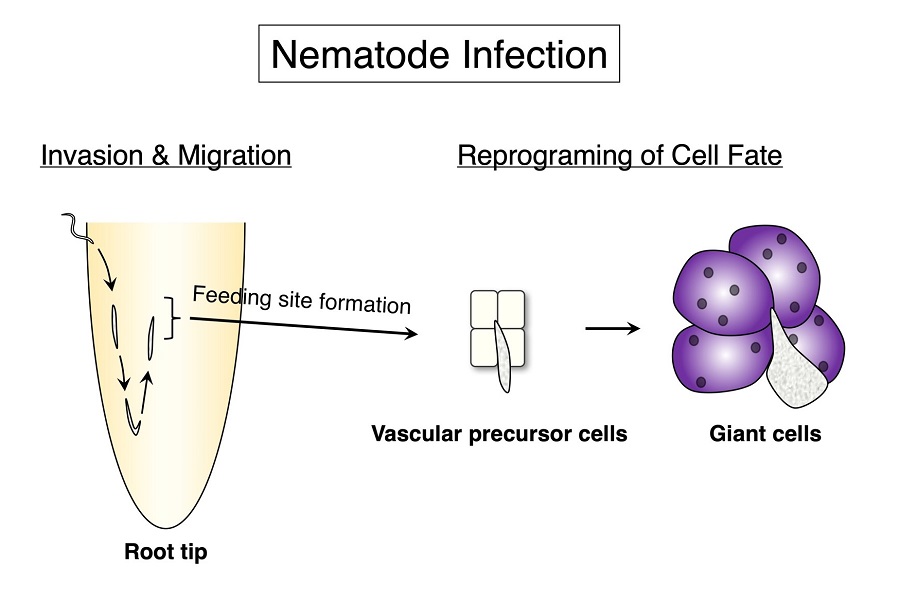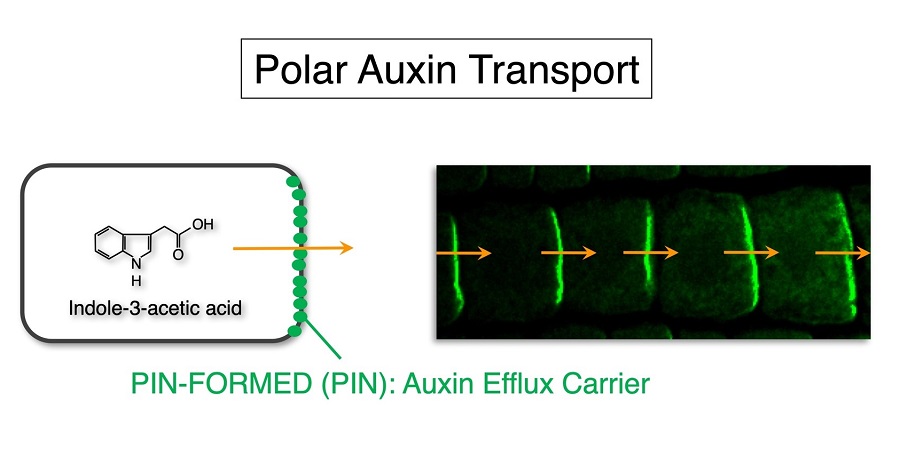STAFF

Dr. Masahiko FURUTANI
- Research Fields
- Plant cell biology, nematode infection in plants, polar auxin transport
- YouTube
- Featured Article
- ma-furut[at]kumamoto-u.ac.jp
*Please replace "[at]" with @.
Research interest
Nematode infection in plants
Infection of plant-parasitic nematodes, such as root-knot nematodes (RNKs), damage a number of crops by feeding on vascular sap containing photosynthetic products and nutrients. RKN larvae penetrate the host plant roots and migrate to the zone containing differentiating vascular cells, where they induce the formation of gall-like organs, special feeding sites. RKNs inject various effectors into precursor vascular cells, which converts these cells into specialized feeding cells known as giant cells via reprogramming cell fate. We aim for understanding molecular mechanisms of feeding site formation and developing new approaches for nematode control.

Polar auxin transport
Phytohormone auxin plays a key role in plant development and environmental response. An asymmetric auxin distribution, established by intercellular transport called “polar auxin transport”, underlies these events. Polarized localization of auxin efflux carriers PIN-FORMEDs (PINs) in the plasma membrane, which drives polar auxin transport, is changed dynamically in response to developmental signals or environmental cues. The aim of my research is to elucidate the molecular mechanism by which localization of PIN proteins is controlled in response to developmental signals and environmental cues. We also aim for manipulating plant development and environmental response in the field based on our basic knowledge of auxin transport.

Achievement
Publications
- in press
- 2024
- 2022
Grants
Grant-in-Aid for Scientific Research(C), (The Japan Society for the Promotion of Science), "Liquid-liquid phase separation in the regulation of polar auxin transport (液-液相分離が担うオーキシン輸送制御機構の解明)", April, 2023-March, 2026
- STAFF
-
- Wei XU
- Shinichiro Sawa
- Tetsuya KIDA
- Armando T. QUITAIN
- Junhua WANG
- Yoshihiro SEKINE
- Akira UEDA
- Yusuke INOMATA
- Muhammad Sohail AHMAD
- Jonas Karl N. AGUTAYA
- Nobleson KUNJAPPY
- Prafulla Bahadur MALLA
- Mohammad Atiqur RAHMAN
- Reetu Rani
- Kei TODA
- Tomoyasu MANI
- Agus Pulung SASMITO
- Tung Thanh TRAN
- Dario ZAPPA
- Daniel P. ZITTERBART
- Mitsuhiro AIDA
- U Rajendra ACHARYA
- Dmitri Aleks MOLODOV
- László PUSZTAI
- Yufeng ZHENG
- Gaochuang CAI
- Masahiko FURUTANI
- Hiroki MATSUO
- Zhongyue ZHANG
- Adam Karl SCHWARTZKOPFF
- Takashi ISHIDA
- Takumi HIGAKI
- Takahiro HOSONO
- Kei ISHIDA
- Makiko KOBAYASHI
- Ruda LEE
- Yuta NAKASHIMA
- Shin-Ichi OHIRA
- Atsushi SAINOKI
- Mitsuru SASAKI
- Keitaro TAKAHASHI
- Suttichai ASSABUMRUNGRAT
- Josep-Lluís BARONA-VILAR
- Nicorae BARSAN
- Jorge Norberto BELTRAMINI
- Olivier BOUTIN
- Paul BOWEN
- Pierre BREUL
- Maria Jose COCERO
- Patrice DELMAS
- Martin DIENWIEBEL
- Martino DI SERIO
- Derek ELSWORTH
- Carolina ESCOBAR
- Bruno FAVERY
- Etsuko FUJITA
- Tomonari FURUKAWA
- Jens HARTMANN
- Mohammad Abul HASNAT
- Yang JU
- Hoon KIM
- Ick Chan KWON
- Wen-Shing LEE
- Youn-Woo LEE
- Pavel LEJČEK
- Dongfang LIANG
- Bo LIU
- Tao LIU
- Hui LU
- Reiko ODA
- Yong Il PARK
- Shie-Ming PENG
- Christian RENTENBERGER
- Parasuraman SELVAM
- Amir SI LARBI
- Konstantinos Daniel TSAVDARIDIS
- Gioacchino (Cino) VIGGIANI
- Thomas WAITZ
- Yan XIAO
- Zhenghe XU
- Kazuki TAKASHIMA

